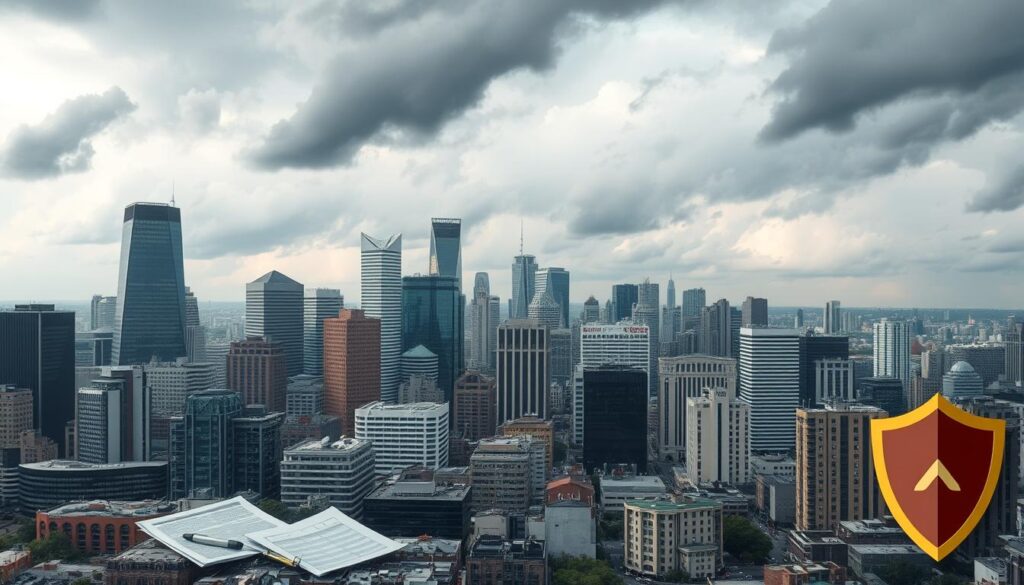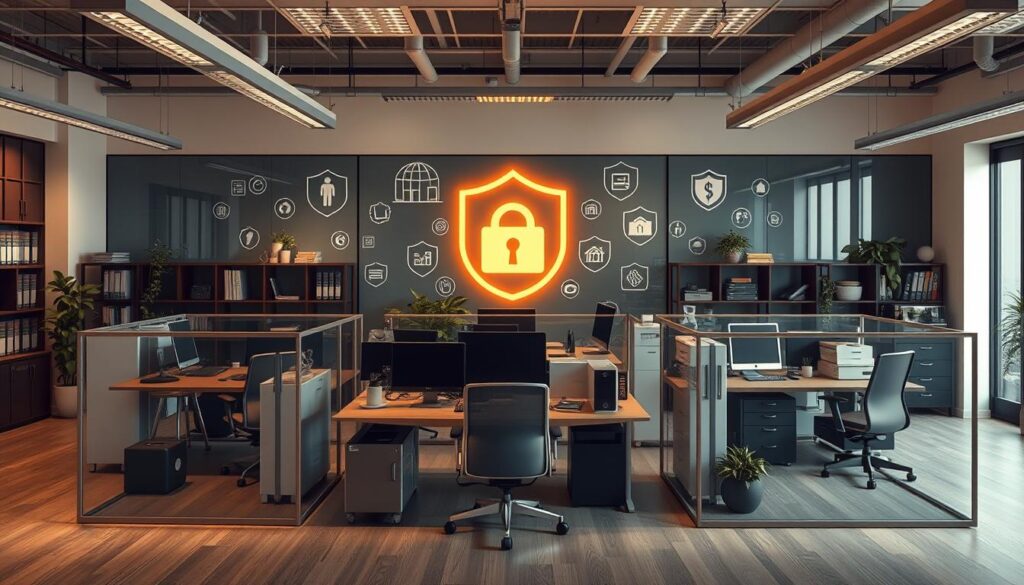Did you know that property damage and theft cost U.S. businesses $102 billion each year? This shows how important property insurance is for businesses. It helps protect your company’s buildings, equipment, and inventory. This is key for keeping your business successful and financially stable.
Property insurance for businesses covers many risks. It makes sure your company is safe from unexpected disasters or accidents. This article will cover the main points of property insurance for businesses. It will help you understand your options, assess risks, and pick the best policy for your assets.
Key Takeaways
- Property insurance for businesses is essential for protecting your company’s physical assets from a variety of risks.
- Understanding the types of property covered and the risks and perils included in your policy is crucial for ensuring adequate coverage.
- Assessing your business’s unique property risks is the first step in choosing the right property insurance coverage.
- Evaluating insurance providers and customizing your policy to meet your specific needs can help you find the best protection for your business.
- Proper property insurance coverage can safeguard your company’s assets and ensure its long-term financial stability.
Understanding Property Insurance for Businesses
As a business owner, protecting your assets is key. You need corporate real estate, industrial property, and enterprise asset insurance. Knowing what’s covered and the risks helps you choose the right coverage.
Types of Property Covered
Business property insurance covers many things, like:
- Buildings and structures
- Equipment, machinery, and furniture
- Inventory, raw materials, and supplies
- Outdoor signage and landscaping
Make sure your policy covers all your business’s important assets.
Risks and Perils Included
Insurance protects against many risks, such as:
- Fire and smoke damage
- Vandalism and theft
- Natural disasters, including hurricanes, tornados, and earthquakes
- Water damage from burst pipes or flooding
- Equipment breakdown and power outages
| Property Coverage Type | Risks and Perils Covered |
|---|---|
| Building and Structure | Fire, Vandalism, Natural Disasters |
| Equipment and Machinery | Breakdown, Power Outages |
| Inventory and Supplies | Theft, Damage |
| Outdoor Assets | Weather, Vandalism |
Assessing Your Business Property Risks
Before picking a business property insurance policy, you must understand your company’s unique risks. Look at your facilities’ location, your operations, your assets’ value, and the chance of natural disasters or unexpected events. A detailed risk analysis helps tailor your property insurance coverage to your needs. This ensures your corporate real estate and industrial property are well-protected.
When evaluating your business property risk, think about these points:
- Geographical location and exposure to natural disasters, such as floods, earthquakes, or severe storms
- Type of business operations, including any hazardous materials or processes that could increase the risk of fire or other accidents
- Value and importance of your physical assets, including buildings, equipment, and inventory
- Potential for theft, vandalism, or other criminal activities that could target your organization’s property safeguards
- Availability and adequacy of your current corporate real estate insurance and industrial property insurance coverage
By carefully examining these factors, you gain a deep understanding of your company’s business property risks. This insight helps you choose the right property insurance coverage. It protects your assets and supports your business’s long-term success.

| Risk Factor | Potential Impact | Mitigation Strategies |
|---|---|---|
| Natural Disasters | Damage or destruction of physical assets, business interruption | Proper building construction, emergency planning, adequate insurance coverage |
| Fire and Accidents | Loss of property, equipment, and inventory, potential liability | Fire safety measures, hazardous materials management, liability insurance |
| Theft and Vandalism | Financial loss, disruption of operations, damage to reputation | Robust security systems, employee training, property insurance with crime coverage |
Property Insurance for Businesses: Choosing the Right Coverage
Choosing the right property insurance for your business is key to protecting your assets. Look at the financial health, reputation, and customer service of insurance providers. Choose companies known for quick claims handling and reliable support.
Evaluating Insurance Providers
Do your homework on insurance providers to find the best fit for your business. Check their financial strength, claims history, and how happy their clients are. Also, see if they offer a wide range of property insurance for businesses, including commercial property coverage, business property liability, and enterprise asset insurance.
Customizing Your Policy
After finding a good insurance provider, work with them to tailor a business facilities coverage policy for your needs. You might need to adjust coverage limits, deductibles, and endorsements. This ensures your property insurance for businesses fully protects your assets.
| Coverage Type | Description | Recommended Limits |
|---|---|---|
| Commercial Property Coverage | Protects your business’s physical assets, including buildings, equipment, and inventory. | Replacement cost value of your property |
| Business Property Liability | Covers legal liability for injuries or property damage that occur on your business premises. | $1 million per occurrence, $2 million aggregate |
| Enterprise Asset Insurance | Safeguards your business’s intangible assets, such as intellectual property and data. | Varies based on the value of your intangible assets |
By carefully choosing insurance providers and customizing your property insurance for businesses policy, you can protect your company’s vital assets. This way, you can safeguard against many risks and dangers.

Conclusion
Protecting your business’s physical assets with property insurance is key to its long-term success. It ensures your company’s financial stability. Knowing what property is covered and the risks your business faces helps you choose the right policy.
Property insurance covers your buildings, equipment, and inventory. It gives you peace of mind and financial security. By picking the right policy for your business, you protect your most valuable assets from disasters or unexpected events.
Choosing property insurance for your business is a smart move. It lets you focus on growing and innovating. With the right coverage, you can face challenges and opportunities with confidence. Your physical assets are safe from threats.

